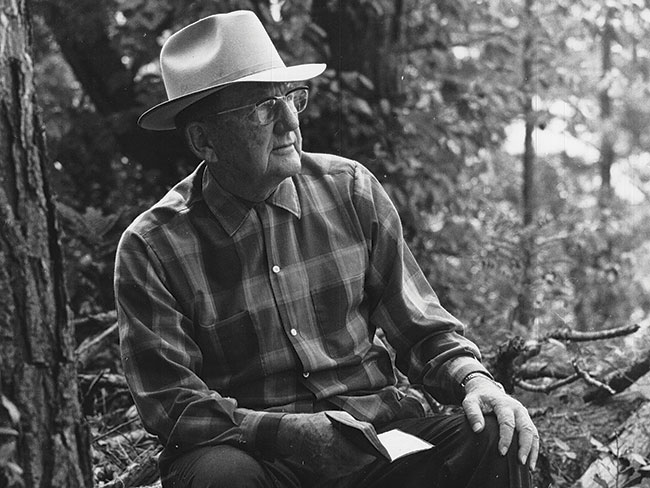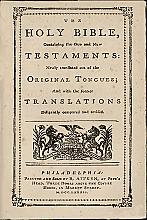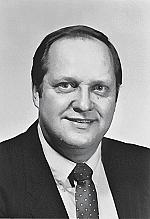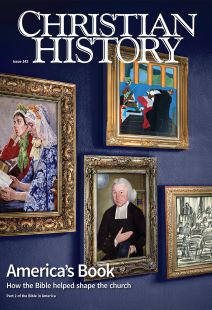Preaching the gospel remedy

[Cameron Townsend with Bible—© Wycliffe Bible Translators]
William Bradford (c. 1590–1657)
Born in Yorkshire, England, Bradford was orphaned young and developed a love for the Bible from an early age. As a teenager he joined the Separatists, who sought to return to the way of the early Christians and unburden themselves from what they viewed as the ritual trappings of the Church of England. They escaped persecution from King James I, living in the Netherlands for more than 10 years.
Eventually the king granted a group of Separatists permission to settle in the Americas. Bradford and his wife, Dorothy, traveled aboard the Mayflower in 1620, landing near Cape Cod. Bradford was one of 41 men who signed the “Mayflower Compact,” the first governing document of their new settlement, Plymouth Colony. Half of the Mayflower passengers died that first winter, including Dorothy. Bradford became first elected governor of the colony in 1621 and went on to serve (off and on) for more than 35 years.
As he governed Bradford also took to his pen to record the early years of the colony, including the Mayflower journey. Of Plymouth Plantation, the result, is a detailed journal account of settlement life from 1620 to 1646 (see CH issue #138). Bradford echoed the Israelites’ adversities in his account of those faced by the Pilgrims, looking to the Bible for both understanding and comfort:
Ought not the children of these fathers rightly say: “Our fathers were Englishmen which came over this great ocean, and were ready to perish in this wilderness; but they cried unto ye Lord, and He heard their voyce, and looked on their adversitie.” Let them therefore praise ye Lord, because He is good, and His mercies endure for ever.
John Eliot (c. 1604–1690)
John Eliot (see p. 32) was born to a wealthy family in England, graduated from Cambridge in 1622, and fled to Massachusetts in 1631 to escape persecution for his Puritan faith. He became the pastor of First Church in Roxbury and married Hanna Mumford the following year. Eliot’s 1640 Bay Psalm Book—an edition of the Psalms written in metrical verse—has the distinction of being the first book published in America.
Eliot had a heart for indigenous American peoples, wishing to evangelize them in their native language. English settlers had captured a Montaukett man named Cockenoe in 1637 during the Pequot War, and he became a servant of a local fur trader. Cockenoe helped Eliot translate the Ten Commandments, the Lord’s Prayer, and other passages of the Bible into the Wampanoag language.
Eliot continued to learn Wampanoag and began preaching in the language in 1647. He also began to translate sermons into Wampanoag, functionally helping to create a written alphabet for a people who mostly used oral and pictographic language. In 1663 Eliot published the Mamusse Wunneetupanatamwe Up-Biblum God, called in English the Algonquian Bible. It was both the first translation of the Bible into an indigenous American language and the first Bible published in the Americas.
Eliot’s ministry was not perfect: the “praying Indians” often had to leave behind their culture and conform to English ways to be baptized. But Eliot, the “Apostle to the Indians,” continued to minister to and love the indigenous people until his death in 1690.
Jonathan Edwards (1703–1758)
The only son in a family of 11 children, Jonathan Edwards was born in Connecticut in 1703. He started at Yale at age 12 and there developed his love for nature and natural philosophy. While gaining in scientific knowledge pushed some in his era away from traditional Christianity, Edwards found in nature God’s glorious design for the world.
In 1727 Edwards was ordained as the minister of the church in Northampton, Massachusetts. Later that same year, Edwards married Sarah Pierpont (1710–1758), and the couple had 11 children. He began preaching on the need for individual faith, which started a storm of conversions leading to a revival in 1734. Though many who had not met him assumed Edwards was a demonstrative preacher, a witness recalled,
He scarcely gestured or even moved, and he made no attempt by the elegance of his style . . . [instead he persuaded people] with overwhelming weight of argument and with such intenseness of feeling.
Though Edwards preached quietly, attendees often swooned and clamored, which conservative Congregationalist ministers openly criticized. News of Edwards’s preaching reached England; English preacher George Whitefield (1714–1770) soon addressed congregations throughout Massachusetts, including Edwards’s own church. The revival quickened.
Edwards believed that only individuals who had made personal professions of faith could take Communion, a stance his church rejected. So in 1751 he became pastor of a church in Stockbridge, Massachusetts, while also ministering to local Native Americans. He died in 1758 as a result of a smallpox inoculation.
John Nelson Darby (1800–1882)
John Nelson Darby was born in London to a well-known landowning Anglo-Irish family. At both Westminster School and Trinity College, Darby grew in his Christian faith, and after practicing law for four years, he switched courses to become a priest in the Church of Ireland. He loved ministering to his parishioners, though he quickly became jaded with the state church. He later wrote,
It is positively stated that the church would fail and become as bad as heathenism. The Christian is directed to turn away from evil and turn to the Scriptures, and Christ is revealed as judging the state of the churches.
Several years after becoming a priest, Darby quit to unite with other disenchanted Christians in a group simply called “Brethren” (later the Plymouth Brethren). They had no minister, desired to abide by the Holy Spirit, and rejected denominationalism. In 1828 he wrote The Nature and Unity of the Church of Christ, and he spread his form of anti-denominationalism throughout churches in Europe, North America, Australia, and New Zealand.
In addition to Darby’s view of ecclesiology, his followers were attracted to his understanding of history, especially the end of history. He believed that in history, God revealed his plan progressively, resulting in seven different “dispensations”: Paradise, Noah, Abraham, Israel, Gentiles, the Spirit, and the Millennium. In his literal biblical interpretation, Darby asserted that Christ would take up believers in the rapture, and Christ would return with all his saints in his Second Coming. Darby’s dispensationalism became widely known in North America through Cyrus Scofield’s Scofield Reference Bible (first released in 1909), and it remains a popular view of the end times among conservative evangelicals today. (For more on Darby, see CH 128.)
Emma Dryer (1835–1925)
Born in Massachusetts and orphaned young, Emma Dryer grew up with her aunt, who made sure Dryer had a thorough biblical education. She went on to graduate from a women’s college in New York, after which she taught astronomy and math for two years, became the principal at a women’s college in Illinois, and later taught grammar and drawing at what is now Illinois State University in Bloomington, Illinois.
In 1870 Dryer moved to Chicago and became actively involved in charity and mission work. She ministered to inmates in local jails, became the superintendent of the YWCA, and helped spread the gospel through her church connections. D. L. Moody (1837–1891) heard of Dryer’s ministry work and was in awe of her learning and Bible knowledge. They mutually encouraged one another in their evangelistic and ministry training work. By 1878 Dryer was training 17 people as ministers of the gospel for her Bible Work of Chicago organization.
In 1888 Dryer’s Bible Work joined the Chicago Evangelization Society (its creation was a group effort that included Moody and other local Christian leaders). Within a year, however, Dryer decided to separate her organization from Moody’s over differences of opinion. Despite the break Moody said that Dryer was “the best teacher of the Word of God in the United States.” Dryer’s encouragement, persistence, and organizational skills had helped create the Chicago Evangelization Society, which eventually became the Moody Bible Institute after she left it.
The Chicago Bible Society’s Annual Report of 1901 showed the vast dedication Dryer had to the gospel and the people of Chicago. That year Dryer and her 13 coworkers had made more than 13,000 home visits to meet the physical and spiritual needs of the poor and sick. After retiring in 1903, Dryer supported the China Inland Mission and was elected superintendent emeritus of the Bible Workers’ Home.
William Cameron Townsend (1896–1982)
Born in Southern California, William Cameron Townsend felt the call early in his life to share the Bible with the people of South America, writing: “The greater need is where the greatest darkness is.” In 1917 through the Los Angeles Bible House, Townsend traveled to Guatemala to sell Bibles in Spanish to the local people. He soon discovered, however, that many of the locals did not speak Spanish but instead had their own indigenous languages.
Their Spanish-speaking compatriots considered the indigenous Cakchiquel people ignorant. Townsend, however, was impressed with the people when they put to him a question: is the God of the Bible only God to people who speak English and Spanish?
Townsend believed God had sent him on a new mission. For a decade he dedicated his time to learning, creating an alphabet for, and translating the New Testament into the Cakchiquel language. He also set up a school, a medical clinic, and an agricultural supply store. Townsend believed that only addressing the spiritual needs of the people is insufficient; he wanted to help meet their physical needs as well.
Although Townsend cherished his work with the Cakchiquel people, he knew thousands of other language groups were without the Bible. In 1934 he started Camp Wycliffe to train people to translate the Bible into these languages. Camp Wycliffe quickly grew and is today Wycliffe Bible Translators and Summer Institute of Linguistics.
Townsend once said, “The greatest missionary is the Bible in the mother tongue. It needs no furlough and is never considered a foreigner.” Thanks to his 60 years of service in Latin America, the Bible is accessible to indigenous communities in Guatemala, Peru, Mexico, and Colombia. His two translating organizations continue their work today: 550 languages have the whole Bible, 1,300 have the New Testament, and 1,800 still require a Bible translation.
Carl F. H. Henry (1913–2003)
The son of German immigrants, Carl F. H. Henry grew up in New York and as a young man pursued a career in journalism. Within a few years of his quick and successful ascent in the newspaper world, however, Henry became a Christian and started attending Wheaton College in Illinois. He went on to get a ThD at Northern Baptist Theological Seminary and a PhD at Boston University.
Ordained as a Baptist minister, he served as a professor, helped launch the National Association of Evangelicals, and was cofounder and first acting dean of Fuller Theological Seminary. He also became the first editor-in-chief of the influential Christianity Today magazine created by Billy Graham.
As a critic of American fundamentalism, Henry wrote The Uneasy Conscience of Modern Fundamentalism in 1947 as a clarion call to Christians of the time. While he rejected liberal Christianity and held to the truth of the Scriptures, Henry also considered the lack of civil engagement among fundamentalists to be anti-Christian. He believed that to be a Christian is to engage in the conversations society is having, always ready to be a witness for Jesus and intellectually curious about how the gospel interacts with the world.
Henry’s impact on evangelical Christianity was solidified with his six-volume God, Revelation, and Authority. Completed in 1983, the series is concerned with biblical revelation and epistemology. Founding dean of Trinity Evangelical Divinity School Kenneth Kantzer called Henry “the dean of evangelical theologians.” Henry died in 2003 at the age of 90. (For more on Henry, see CH 141.)
Beth Moore (b. 1957)
Beth Moore was raised in Arkansas in a family dedicated to their Southern Baptist congregation. As a young woman teaching Sunday school, Moore wanted a more thorough biblical education, so she started attending a doctrine class. As she continued her biblical education, she began to share her own devotionals during the exercise class she taught at her church, First Baptist in Houston. She continued teaching the Bible in a church class, soon bringing in 2,000 women each week. By the 1990s she was teaching at churches throughout South Texas.
In 1994 Lifeway Christian Resources began publishing Moore’s Bible studies, and soon she was holding conferences throughout the United States. The same year she launched Living Proof Ministries, whose motto is “dedicated to encouraging people to come to know and love Jesus Christ through the study of Scripture.” Her studies have been translated into more than 20 languages, she continues to host live conferences, and she teaches the Bible on the Trinity Broadcasting Network.
As a child she suffered from sexual abuse and later recalled, “My local church, growing up, saved my life. So many times, my home was my unsafe place. My church was my safe place.” Many were surprised, therefore, when in 2021 Moore declared she was no longer a Southern Baptist. Though Moore expects her conferences to be smaller following her departure from the denomination, she says she remains ready to teach the Bible with gusto: “I am going to serve whoever God puts in front of me.”
CH
By Jennifer A. Boardman
[Christian History originally published this article in Christian History Issue #143 in 2022]
Jennifer A. Boardman is a freelance writer and editor. She holds a master of theological studies from Bethel Seminary with a concentration in Christian history.Next articles
The virtual Word in the real world
Some popular websites dedicated to making free Bible texts and resources available.
Jennifer Woodruff TaitThe Bible for the church
Use these questions on your own or in a group to reflect on how the Bible has formed you and your church.
the editorsThe Bible in America: recommended resources
Read more about how the Bible has shaped the American church in these resources recommended by our authors and CH staff.
the contributors and editorsExecutive editor’s note
With this special fortieth-anniversary issue, we are delighted to honor Ken’s memory and celebrate God’s faithfulness by overviewing the whole scope of Christian history in images.
Bill Curtis and Michelle CurtisSupport us
Christian History Institute (CHI) is a non-profit Pennsylvania corporation founded in 1982. Your donations support the continuation of this ministry
Donate







